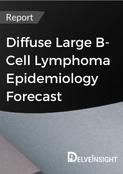diffuse large b cell lymphoma epidemiology forecast
Key Highlights
- Epidemiology assessed for DLBCL showed that the US, in 2024, accounted for approximately 32,300 incident cases DLBCL.
- The total number of Incident cases of DLBCL in Japan is projected to rise from 13,200 in 2024.
- About 30–40% of people with DLBCL use to have localized Stage I or II diseases when they are diagnosed. The rest may have widespread disease at the time of diagnosis.
- DLBCL has many subtypes and according to analysis, DLBCL, NOS accounts of majority of B-cell patient population, In the US there were 27,450 cases observed for DLBCL, NOS in 2024.
DelveInsight’s “Diffuse Large B-cell Lymphoma (DLBCL) – Epidemiology– 2034” report delivers an in-depth understanding of DLBCL, historical and forecasted epidemiology in the United States, EU4 (Germany, France, Italy, and Spain) and the United Kingdom, and Japan.
Geography Covered
- The United States
- EU4 (Germany, France, Italy, and Spain) and the United Kingdom
- Japan
Diffuse Large B-cell Lymphoma (DLBCL): Disease Understanding
Diffuse Large B-cell Lymphoma (DLBCL) Overview
NHL is a cancer of the lymphatic system, characterized by the abnormal accumulation of mature B-cell clones. Symptoms include painless swollen lymph nodes, weight loss, fever, night sweats, and fatigue. DLBCL, the most common and aggressive NHL subtype, arises in lymph nodes or extranodal sites like the gastrointestinal tract, skin, or brain. It often presents with rapid, painless swelling in the neck, armpits, or groin, along with systemic symptoms. Advances in treatment have made DLBCL curable through chemotherapy, immunotherapy, and gene therapies. R-CHOP is the standard regimen in the US, EU, and Japan. DLBCL is classified based on molecular subtypes (GCB, ABC), location (CNS, cutaneous, intravascular), and stage.
Diffuse Large B-cell Lymphoma (DLBCL) Diagnosis
DLBCL is diagnosed through an excisional lymph node biopsy, revealing large atypical cells positive for CD20 and CD79a. Immunohistochemistry determines the cell of origin, while FISH detects high-risk genetic features like double-hit or triple-hit disease. Commercial mutation tests are not standard for treatment decisions. A tissue biopsy is required for diagnosis, typically under local or general anesthesia. Most patients present with lymphadenopathy, and up to 40% have extranodal involvement. Common sites include the CNS, gastrointestinal tract, and bone, with 30% experiencing systemic B symptoms like fever and weight loss.
Excisional biopsy is preferred, but if inaccessible, core needle biopsy (CNB) and fine-needle aspiration (FNA) with additional testing may suffice. Immunophenotyping via immunohistochemistry or flow cytometry, along with cytogenetic analysis, confirms diagnosis and detects key chromosomal translocations. Staging involves CT or PET/CT scans, with bone marrow biopsy or lumbar puncture if needed. Limited-stage disease affects one area, while advanced-stage disease spreads to multiple organs.
Further details related to diagnosis are provided in the report…
Diffuse Large B-cell Lymphoma (DLBCL) Epidemiology
The DLBCL epidemiology chapter in the report provides historical as well as forecasted epidemiology segmented by total incident cases of DLBCL, gender-specific cases of DLBCL, age-specific cases of DLBCL, type-specific cases of DLBCL, and stage-specific incident cases of DLBCL in the 7MM covering the United States, EU4 (Germany, France, Italy, and Spain), United Kingdom, and Japan from 2020 to 2034.
- In 2024, the total incident cases of DLBCL were about 77,000 in the 7MM.
- Among EU4 and the UK, the highest number of incident cases of DLBCL were found in Germany (~7,740), followed by France (~7,000). At the same time, Spain accounted for the lowest number of incident cases (~3,740) in 2024.
- In Japan, males were more affected by DLBCL than females.
- Among the gender-specific contribution, males are affected more by DLBCL than females. In 2024, there were 18,100 cases of DLBCL in males and 14,210 cases in females in the US.
- Among EU4 countries and UK, the age group of 75-84 years accounted for the highest cases of DLBCL in 2024, followed by 65-74 years and more than 84 years. In contrast, the least cases were found in the age group of less than 20 years.
DLBCL Report Insights
- Patient population
- Country-wise epidemiology distribution
DLBCL Report Key Strengths
- Ten years forecast
- 7MM coverage
- DLBCL epidemiology segmentation
DLBCL Report Assessment
- Unmet needs
- Current diagnostic practices
FAQs
- What are the disease risks, burdens, and unmet needs of DLBCL? What will be the growth opportunities across the 7MM concerning the patient population with DLBCL?
- What is the historical and forecasted DLBCL patient pool in the US, EU4 (Germany, France, Italy, and Spain), the UK, and Japan?
Reasons to buy
- Insights on patient burden/disease incidence, evolution in diagnosis, and factors contributing to the change in the epidemiology of the disease during the forecast years.
- To understand KOLs’ perspectives around the accessibility, acceptability, and compliance-related challenges of DLBCL to overcome barriers in the future.
- Detailed insights on various factors hampering disease diagnosis and other existing diagnostic challenges.


